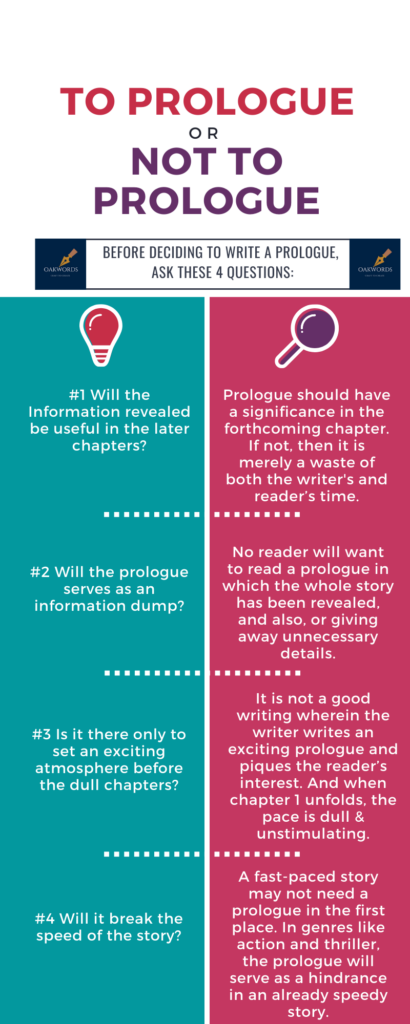More often than not, the writers are unsettled about how to write a prologue. They find themselves dubious about whether a prologue should be in their novel or it should straight begin with the first chapter.

A prologue can be a great tool to arouse a reader’s interest. Think of it as a trailer of a movie, that may help a viewer decide whether the movie is worth watching or not.
Tweet
Before we discuss prologue writing examples, let us understand what a prologue is.
Prologue Meaning
The origin of the word ‘Prologue’ is in the Greek word ‘Prologos’ which means ‘before word’. As the name suggests, a Prologue is a way to provide the background details of a story; it acts as an introduction to the theme, characters, events that may play out in the story and sometimes, the events that have taken place before the story begins.
A prologue lays out a set of information which is important further in the story. It is an integral part of the plot because it has a direct impact on the story, or the information given in the prologue will serve its importance somewhere in the book, in a crucial manner.
Now, many may confuse a prologue with a preface, foreword, introduction or an epilogue of a book or novel. Let us know the difference. let us now discuss why writers should or should not decide to write a Prologue.
Prologue, Preface, Foreword, Introduction, Epilogue- are NOT the same

Prologue meaning:
A prologue is the onset of a story; prepares the readers about what events may take place in the story, introduces the protagonist and/or other characters, the theme of the story, the era of the story it is taking place in.
Preface:
A preface is about the book; how it came to an existence, what inspired the author to write it, what the process was, how a simple event or experience led to the creation of a full-fledged novel or a book, the objective of the book, the involved parties which/who contributed in the development of the book. It is mostly written in non-fiction books, but it can be written for fiction also.
Foreword:
A foreword also comes before the story and is similar to an introduction. But it is not written by the author of the book. It is written by someone else who may/may not be related to the author. The foreword writer does not give away the story; he talks about the association with the book or the author, the praises of the book, any thoughts of criticism etc. it can be written both for non-fiction and fiction books.
Introduction:
An Introduction to the book, as the name suggests, speaks about the story for the reader’s comprehension. It may be perceived to be similar with a Preface, but the difference is that the preface talks about the writer’s perspective whereas, an introduction is for the reader to understand the basis of the book (fiction/non-fiction). It enables the reader to have a ground of understanding before they go to Chapter 1.
Epilogue:
An Epilogue is just like a prologue with only one difference that it comes at the end of the story. Epilogue speaks about the implications of the events that occurred in the story on the characters, the story on the whole.
5 Reasons to Not Ditch Your Novel’s Prologue:

Before you learn how to write a prologue, understand the importance of a prologue and why they are required.
- They give a quick glimpse of the story, a set of background details with no necessary dialogues or dream sequences or flashbacks.
- Introduction of the characters; primarily the antagonist(s) and/or the protagonist(s). Their intentions, or purposes.
- Information about the era in which the story has been set in, the philosophy and the beliefs significant to the story.
- Engagement of the reader with the pivotal plot- arising questions for the reader which will have the answers in the later chapters of the book.
- A pinch of suspense as a means of harbinger of the events to take place.
To Prologue or Not to Prologue?
It would be unfair to say that all prologues are welcomed with open arms because they set a background of the story. Many writers make the mistake of writing a prologue which has no substantial connection with the story. And this practice forces the publishers to dismiss the whole script without turning another page.
It’s important to know when and how to write a prologue. The infographic below will help you find answers to the ‘When’ part. You can skip to the next section to learn about ‘how’ part of writing a prologue.

How to write a prologue:
Now that we have established the need for prologues, the time comes to actualise it. How to write a prologue that will grip the editor’s and then the reader’s attention; that will not look out of place when chapter 1 starts; that will not make the reader put the book back on the shelf. In this section, we’ve got for you the best prologue writing examples.
Prologue Writing Examples
Crisp and Interesting:
An interesting prologue with crisp words, which sets the story right into the motion is a prerequisite of a good novel or non-fiction. A good prologue is not long, essay type or boring. It should cover the basic elements: Introduction of the character(s), the tone, era and the philosophy of the story, a substantial part of the information which will be vital to the plot.
Two households, both alike in dignity, In fair Verona, where we lay our scene, From ancient grudge break to new mutiny, Where civil blood makes civil hands unclean.
Romeo and Juliet,” William Shakespeare (1591-1595)
Language:
The language of the prologue should be consistent. It should not keep changing as the prologue progresses. For instance, prologue in a thriller novel should not have comic components.

Background Information:
The prologue, as mentioned earlier, should not be an information dump; it should reveal only that is enough for the reader to get a hunch about what the story is going to be. Sure, the prologue of Romeo and Juliet tells the reader everything in it. And if so is the case, then the writer must make sure to incite enough interest in the reader’s mind that he wants to read to know everything.

Not a resolution but a beginning:
A good prologue is like a short story in itself, except for its end. A prologue’s ending is the beginning of the story, and a prologue is an introduction to it. So, the end of the prologue must not have a resolution or conclusion. Instead, it should be laid out as an opening to the start of the story.

Stand out amongst the whole plot:
A prologue, being an introduction to the story, should stand out. And for that to happen, the POV of the prologue should be best left for the narrator, that is, someone who is not a character in the story. It makes the prologue distinct, and helpful in setting a tone.
How to write a prologue your readers won’t skip:
A prologue is an important part of the story but it is not a necessary one. If a writer is unsure of writing a prologue, then he should probably skip it and start with chapter 1. But a well-written prologue becomes a great way to give the story a kickstart. The editors may want to skip the prologue of the story, and the reader too would like to jump to the first chapter. Therefore, if a prologue is short, succinct and stimulating, it is a go.
And to answer ‘how to write a prologue your readers won’t skip’, I hope these prologue writing tips will help:
- Keep it short.
- Don’t label it as a “prologue.”
- Make it exciting. Don’t make it too vague or mysterious.
- Write it in a narrative (POV) that continues in the rest of your novel.
- Instead of writing a snippet, think of it as a short story that can stand out, without the information dump.
- Before you write a prologue, read prologues of other novels.


It was good,and we’ll explained…
Ԍreetings! Very helpful advice in this particular article!
It’s the little changes that make the ⅼargest changes.
Many thanks for shаring!
Appreciated article, and some more than basic definitions on the power & purpose of proper prologues! Thanks.
Thank you so much, Andre! Would love to know your thoughts on other topics as well. 🙂 Happy Reading! 🙂